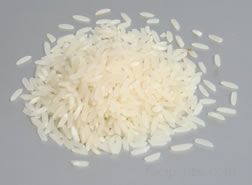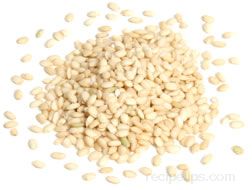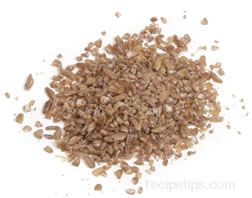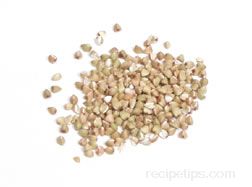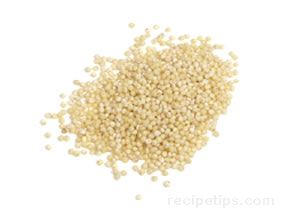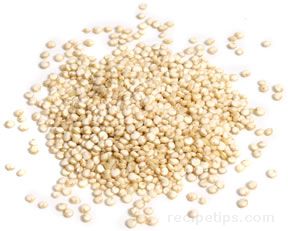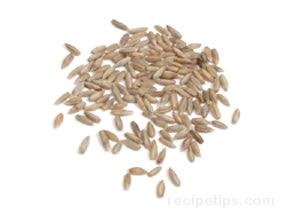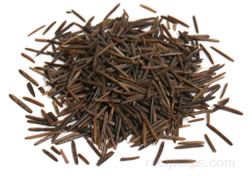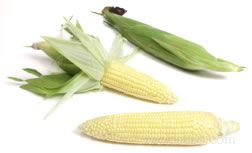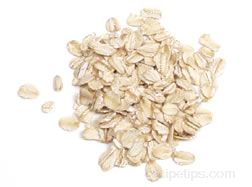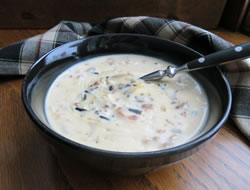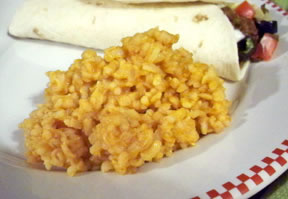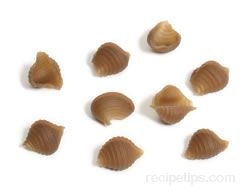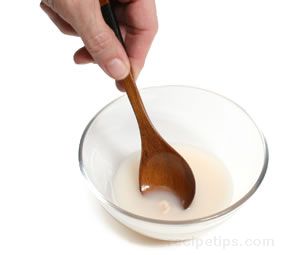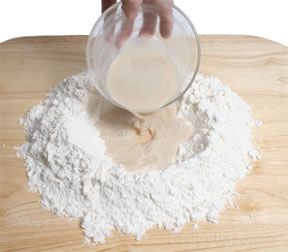Cooking Rice with the Absorption Method | Cooking Paella | Cooking Risotto
Cooking Rice with the Absorption Method
|
When cooking rice with the absorption method, the proper quantity of water to use is based on the amount that usually can be absorbed by a specific quantity of rice. Most often, 1¾ to 2¼ cups of water is adequate for 1 cup of long-grain brown rice, but again, the amount of water may vary because of certain variables. |
| Using a pan with a heavy bottom, add 1¾ to 2¼ cups of water and bring it to a boil over high heat. | 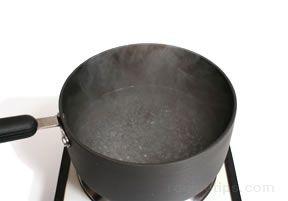 |
| Add 1 cup of long-grain brown rice and return to a boil. | 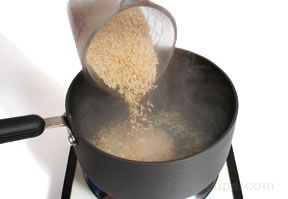 |
|
Reduce the heat to very low, place a cover over the pan, and allow the rice to simmer and steam. Long-grain brown rice requires about 45 to 50 minutes of cooking time unless it has been soaked in cold water for several hours. In most cases, soaking allows the cooking time to be cut in half. Long-grain white rice requires 15 to 20 minutes cooking time (without soaking prior to cooking). The rice should not be checked until the end of the designated cooking time. When the water has been absorbed, remove the pan from the heat and let the rice stand, covered for 5 to 10 minutes. |
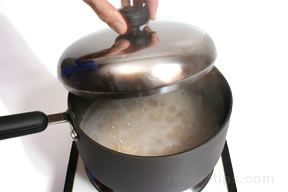 |
| Fluff the rice with a fork prior to serving. One cup of uncooked rice produces about three cups of cooked rice. | 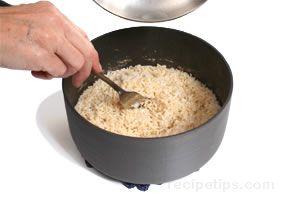 |
| One of the most common errors made by the home cook when preparing rice with the absorption method is to remove the lid on the pan frequently to check the progress of the water absorption. It is important to keep the moisture (in the form of steam) in the pan. It is also important not to stir the rice during the cooking process because stirring releases starch from the rice, which will cause it to become sticky. While the rice is cooking, simply cover the pan and forget about it until the cooking time has expired; then check it. |
| Note: Do not add salt during the cooking time when using this method because salt will lengthen the cooking time. Salt can be added to taste after the rice is cooked. |
Cooking Paella
|
Paella is a traditional Spanish one-pan meal made with rice and numerous ingredients including various types of fish, seafood, poultry, sausage, and vegetables. There are many different versions and varieties of paella depending on the region of Spain where the recipe is popular; however, the original home of paella is the Valencia area of Spain, where the geography and environment are excellent for cultivating rice. Valencia rice is a medium-grained, plump variety that is capable of absorbing a large volume of liquid. The grains are slightly sticky when cooked, yet the grains separate easily, which makes it perfect for paella. Other types of Spanish rice, such as Bomba and Bahia, are equally good for preparing paella.
The word "paella" actually refers to the type of pan that a paella recipe is cooked in, but the word has also come to refer to the food cooked in the pan. A paella pan is usually shaped like a large shallow skillet with handles on either side and can be constructed from cast iron, enameled metal, or brushed aluminum. The shallow pan prevents the rice from steaming and becoming mushy. The diameter of the pan is usually fourteen to sixteen inches and is often too large to fit on one burner on a stovetop, so it is beneficial to use two burners to heat the pan more evenly. Paella was traditionally cooked on an open fire (and often still is), so it was much easier to heat the entire pan. Paella is known for the dry, separate rice grains of the top layers that are accompanied by a browned crusty layer of rice that forms on the bottom of the pan. This browned layer is known as "socarrat" and is the result of cooking the rice uncovered and unstirred (after the liquid is added), especially when cooking the paella with the traditional method over an outdoor wood burning fire. The amount of browned rice on the bottom of the pan also depends on the recipe: Some recipes call for the rice to be stirred, which does not allow the socarrat to form, while other recipes call for only occasional stirring to blend the ingredients as they are added to the pan. When using a stovetop for cooking paella, the cooking process is often finished in the oven where the paella bakes uncovered for approximately ten to forty minutes (depending on the recipe). The paella is then allowed to rest, lightly covered, for ten minutes prior to serving. This allows the rice to continue to cook slowly and prevents the grains form bursting, which would cause the paella to become mushy (which happens if the paella is overcooked on the stovetop or in the oven). Paella can be made as a meat dish, an all-vegetable dish, or as a combination of meats and vegetables. The ingredients will often include meats, such as chicken, pork, ham, and chorizo sausage; shellfish, such as shrimp, lobster, mussels, and clams; and vegetables, such as onions, peas, beans, tomatoes, and artichoke hearts. Garlic and saffron are common seasonings in nearly all types of paellas. Although saffron is the most expensive spice in the world, a little goes a long way, and there is nothing that can duplicate the flavor. A very small container of saffron strands may cost a few dollars, but it lasts a long time. Other substances that are used to mimic saffron, such as turmeric or ground marigold petals, should not be used in paella. Preparing Chicken, Shrimp, and Sausage Paella
|
Cooking Risotto
|
Risotto is a creamy Italian rice dish made with starchy, short-grained Italian rice varieties. A basic recipe for risotto includes onions that are lightly sautéed in butter into which rice is added and cooked briefly. Liquid is added in small increments to allow the rice to absorb the liquid gradually. The rice is stirred constantly, releasing the starch in the rice, which acts as a thickener and results in a very creamy dish that is finished with the addition of butter and grated hard cheese.
Many varieties of Italian rice have characteristics that are unlike rice from any other part of the world, which makes them the best choices for risotto. Italian rice has a high level of amylopectin, which is a soft, translucent starch that dissolves in the cooking liquid and acts as a natural thickener. The outer amylopectin layers of the rice kernel surround the inner amylose, which is a hard, opaque starch that does not dissolve readily during the cooking process. The properties of these two starches allows Italian rice to absorb large volumes of liquid, becoming very creamy, while allowing the texture of the inner portion of the grains to remain somewhat firm, or "al dente." It is important not to rinse Italian rice varieties before cooking in order to retain both the flavor of the rice and the natural thickening properties of the starch that are so important for a successful result. Preparing Basic Risotto
| |
|
In a medium saucepan, heat 5 cups of chicken stock (or any other type of meat stock depending on the flavor desired). After the stock is heated, reduce the heat to very low. |
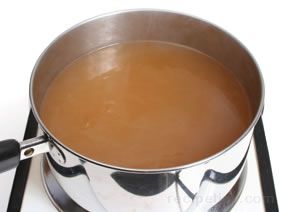 |
| In a separate medium to large saucepan or other cooking pan, melt 3 tablespoons of butter over medium heat. | 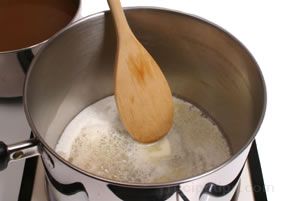 |
| Add ½ cup of finely diced onion to the pan and slowly sweat the onion, stirring occasionally. Do not allow the heat to become too high and do not allow the onion to brown excessively. | 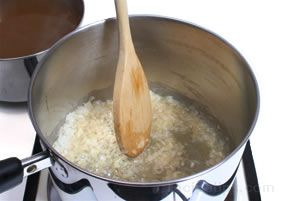 |
| Add 1½ cups of Italian rice to the pan. Immediately, stir the rice (a wooden spoon works well) over medium heat and continue stirring, preventing the rice from sticking to the bottom of the pan. Cook for about 2 minutes. Monitor the heat level so that the rice and onions do not cook too quickly or take on any color. The rice should become slightly translucent. |  |
| Pour in ¾ cup of white wine and stir constantly over medium heat until the liquid has been absorbed. |  |
| Add 1 cup, or a bit less, of the heated chicken stock (or other meat stock) to the pan, stirring constantly but not vigorously, over medium heat. It is helpful to use a ladle to transfer the stock when it is needed. Continue adding the chicken stock in small quantities (a ladle full or two), but only after the rice has absorbed nearly all of the liquid in the pan. |  |
| Do not let the rice become dry before adding stock. Before adding more liquid, the consistency of the rice should be creamy, but not thin and watery. |  |
| After 20 to 25 minutes of stirring and adding liquid, taste the rice for doneness. It should be creamy, but the center of the grains should be al dente. If more cooking time is required, continue stirring and adding stock, or if the stock has been depleted, use warm water. If the rice is done before the stock is depleted, the remaining stock does not have to be used. |  |
| Reduce the heat to low and stir in 2 tablespoons of butter, season with salt and pepper, and add freshly grated Parmesan or similar hard cheese to taste (about a half-cup). Stir the risotto to blend the ingredients; then remove the pan from the heat. Allow the risotto to rest for 2 to 3 minutes prior to serving. |  |
| When used as a main dish, this recipe yields 4 generous servings and when used as a side dish, this recipe serves 6 to 8. The basic risotto recipe is quite substantial on its own, but other ingredients can be included in a variety of combinations. Vegetables, such as zucchini, asparagus, artichokes, or tomatoes; seafood, such as shrimp, clams, mussels, or lobster; and other seasonings, such as garlic, pepper, parsley, saffron, basil, and rosemary, are among the many ingredients that can be added to the basic recipe. | 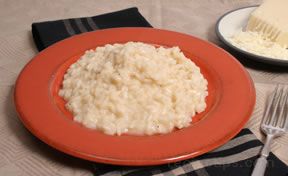 |

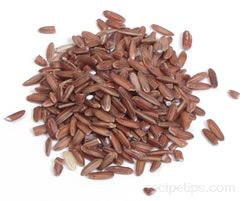




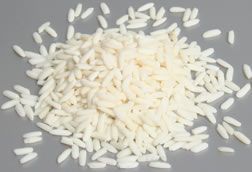 The rice is the most important ingredient in paella, which is the reason why nearly all paella recipes call for Valencia rice or similar short to medium-grain Spanish varieties and caution against using any rice that happens to be on hand (especially long-grain varieties). Paella is not nearly as good when using substitutions. Other rice varieties, such as Arborio from Italy and Pearl or Cal Riso from California, can be used, if necessary, but only if Spanish varieties are unavailable.
The rice is the most important ingredient in paella, which is the reason why nearly all paella recipes call for Valencia rice or similar short to medium-grain Spanish varieties and caution against using any rice that happens to be on hand (especially long-grain varieties). Paella is not nearly as good when using substitutions. Other rice varieties, such as Arborio from Italy and Pearl or Cal Riso from California, can be used, if necessary, but only if Spanish varieties are unavailable.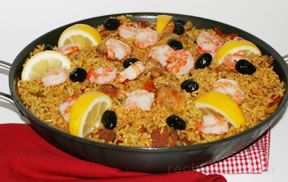 Ingredients
Ingredients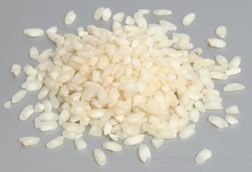 Arborio is the variety of rice that is most often used to make risotto, but many people prefer carnaroli, which is even better than Arborio in absorbing liquid and maintaining its shape and structure. Other Italian rice varieties that are often used for risotto are vialone nano, baldo, and roma. Many large food stores may carry generic brands simply labeled "Risotto Rice" that work fairly well for risotto, but are usually blends of Italian rice varieties and other non-Italian varieties.
Arborio is the variety of rice that is most often used to make risotto, but many people prefer carnaroli, which is even better than Arborio in absorbing liquid and maintaining its shape and structure. Other Italian rice varieties that are often used for risotto are vialone nano, baldo, and roma. Many large food stores may carry generic brands simply labeled "Risotto Rice" that work fairly well for risotto, but are usually blends of Italian rice varieties and other non-Italian varieties.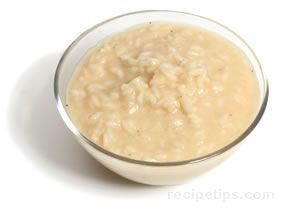 Ingredients
Ingredients